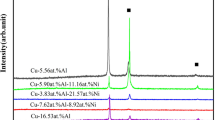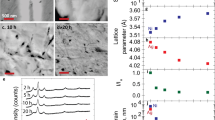Abstract
Development of Kirkendall voids, and determination of interdiffusion coefficients, marker plane movement and intrinsic diffusion coefficients were investigated as functions of marker size and distribution using Cu versus Ni solid-to-solid diffusion couples, annealed at 1000 °C for 48 h. The Al2O3 marker particles, varying in size, 1, 3, 5 and 9 μm, were dispersed in absolute ethanol, with concentration ranging from 0.67 to 33.33 mg/mL. To place the markers in diffusion couple, Ni was immersed in the Al2O3 dispersed ethanol, and removed to quickly dry under a lamp, leaving only the Al2O3 particle makers on the Ni surface. Optical microscopy was employed to document the distribution of Al2O3 particle markers on the Ni surface prior to the diffusion couple assembly. Field emission scanning electron microscopy equipped with x-ray energy dispersive spectroscopy was employed to examine the development of Kirkdendall voids and to determine the concentration profiles. The concentration profiles were analyzed to determine the interdiffusion and intrinsic diffusion coefficients via Boltzmann–Matano and Heumann methods, respectively. As the marker concentration (or cross-sectional area coverage) increased, the Kirkendall voids became more elongated and interconnected, leading to a gap within the interdiffusion zone. Better consistency in the magnitude and composition-dependence of interdiffusion and intrinsic diffusion coefficients were observed with smaller, 1- and 3-μm Al2O3 marker particles in general. For 5- and 9-μm Al2O3 marker particles, only the concentration of 0.67 mg/mL, corresponding to no more than 11% of cross-sectional area coverage was acceptable to yield consistent interdiffusion and intrinsic diffusion coefficients.

















Similar content being viewed by others
References
A.D. Smigelkas and E.O. Kirkendall, Zinc Diffusion in Alpha Brass, Trans. AIME, 1947, 171, p 130–142
H. Mehrer, Diffusion in Solids: Fundamentals, Methods, Materials, Diffusion-Controlled Processes. Series in Solid-State Sciences, Vol 155, Springer, Berlin, 2007, p 212
G.B. Stephenson, Overview No. 75: Deformation During Interdiffusion, Acta Metall., 1988, 36, p 2663–2683
I. Daruka, I. Szabo, D.L. Beke, C. Cserhati, A.A. Kodentsov, and F.J.J. van Loo, Diffusion-Induced Bending of Thin Sheet Couples: Theory and Experiments in Ti-Zr System, Acta Mater., 1996, 44, p 4981–4993
Y. Yin, R.M. Rioux, C.K. Erdonmez, S. Hughes, G.A. Somorjai, and A.P. Alivisatos, Formation of Hollow Nanocrystals Through the Nanoscale Kirkendall Effect, Science, 2004, 304(5617), p 711–714
Y.H. He, Y. Jiang, N. Xu, J. Zou, B. Huang, C.T. Liu, and P.K. Liaw, Fabrication of Ti-Al Micro/Nanometer-Sized Porous Alloys Through the Kirkendall Effect, Adv. Mater., 2007, 19(16), p 2102
G.S. Hartley, Diffusion and Swelling of High Polymers. Part I: The Swelling and Solution of a High Polymer Solid Considered as a Diffusion Process, Trans. Faraday Soc., 1946, 42, p B006
A.E. Paz y Puente, D. Erdeniz, J.L. Fife, and D.C. Dunand, In Situ X-ray Tomographic Microscopy of Kirkendall Pore Formation and Evolution During Homogenization of Pack-Aluminized Ni-Cr Wires, Acta Mater., 2016, 103, p 534–546
Y. Iijima, K.-I. Hirano, and M. Kikuchi, Determination of Intrinsic Diffusion Coefficients in a Wide Concentration Range of a Cu-Ni Couple by the Multiple Markers Method, Trans. Jpn. Inst. Met., 1982, 23(1), p 19–23
M.J.H. van Dal, M.C.L.P. Pleumeekers, A.A. Kodentsov, and F.J.J. van Loo, Intrinsic Diffusion and Kirkendall Effect in Ni-Pd and Fe-Pd solid solutions, Acta Mater., 2000, 48(2), p 385–396
T. Heumann and K. Grundhoff, Diffusion and Kirkendall Effect in the Cu-Ni System, Z. Metallkunde, 1972, 63(4), p 173–180
M.A. Dayananda and Y.H. Sohn, Average Effective Interdiffusion Coefficients and Their Applications for Isothermal Multicomponent Diffusion Couples, Scr. Mater, 1996, 35(6), p 683–688
T. Heumann, Zur Berechnung von Diffusionskoeffizienten bei ein-und mehrphasiger Diffusion in festen Legierungen, Z. Phys. Chem., 1952, 201, p 168–169
L. Wojnar, Image Analysis: Applications in Materials Engineering. CRC Series in Materials Science and Technology, CRC Press, Boca Raton, 1999, p c1999
D. Liu, L. Zhang, Y. Du, H. Xu, and Z. Jin, Ternary Diffusion in Cu-Rich Fcc Cu-Al-Si alloys at 1073 K, J. Alloys Compd., 2013, 566, p 156–163
Author information
Authors and Affiliations
Corresponding author
Additional information
Publisher's Note
Springer Nature remains neutral with regard to jurisdictional claims in published maps and institutional affiliations.
Rights and permissions
About this article
Cite this article
Schulz, E., Mehta, A., Park, S.H. et al. Effects of Marker Size and Distribution on the Development of Kirkendall Voids, and Coefficients of Interdiffusion and Intrinsic Diffusion. J. Phase Equilib. Diffus. 40, 156–169 (2019). https://doi.org/10.1007/s11669-019-00710-6
Received:
Revised:
Published:
Issue Date:
DOI: https://doi.org/10.1007/s11669-019-00710-6




